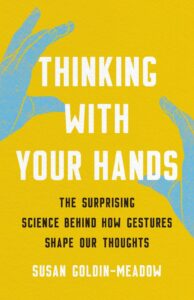Welcome to the latest installment of “Five words from …” our series which highlights interesting words from interesting books!
Thinking with Your Hands, from cognitive psychologist Susan Goldin-Meadow, will open your eyes to the parallel track of communication that is literally in your hands. Thinking with Your Hands is a fascinating, well-written, and deeply researched book on the importance of gesture that will appeal to Wordniks and other language enthusiasts.
emblems
“When people hear I work on gesture, they immediately assume I’m studying gestures like thumbs-up, okay, and shhhh—conventional gestures, called emblems, that everyone in a particular culture knows.”
(If you’re interested in learning more about emblems in different cultures, you may enjoy Dictionary of Gestures: Expressive Comportments and Movements in Use Around the World. Bonus: this Wordnik list of emblematic gestures.)
homesign
“The hand movements are called homesigns (because they were created in the home) and the children homesigners.”
This video shows a Nicaraguan homesigner.
intensional and extensional
“In an intensional event, the object of the action does not exist at the beginning of the event: ‘I baked a cake,’ ‘I drew a picture’—the event involves creating the object. In contrast, in an extensional event, the object is present at the start: ‘I cut the cake,” ‘I ripped the picture’—the event involves acting on an existing object.”
spatialized
“By using gesture, the children ‘spatialized‘ their thoughts (they literally put them out into space), which, in this instance, helped them take more than one perspective on a moral dilemma.”
teachable moment
“It feels like a ‘teachable moment’—a time when teaching a particular topic or idea is relatively easy, often because the learner is focused on what needs to be learned. The concept of a teachable moment was popularized by Robert Havighurst, then a faculty member in education at the University of Chicago, in his 1952 book Human Development and Education. Havighurst used the phrase to refer to a child’s developmental readiness to learn a particular concept. But is is often used (as I use it here) to refer to a child’s heightened interest in a topic, which makes the child particularly receptive to input that targets the topic.”
Havighurst’s book is available at the Internet Archive.
Got a book you’d like to see given the “five words from” treatment? Nominate it through this form, or email us!
